Uganda's growth in 32 years
Jan 26, 2018
Liberation day supplement

Uganda eyes middle income status
By Nicholas Wassajja
American President Donald Trump recently labeled African countries “shitholes”.
A few days ago, President Yoweri Museveni said he “loves” Trump because it is such controversial, but honest statements that will act as a wake up call to the sleeping giant that is Africa.
Reading through the minds of the National Resistance Army (NRA) heroes that set out to capture power 32 years ago, the intention was to transform the country politically, socially and economically, perhaps to avoid the Trump kind of labelling.
 Under President Yoweri Museveni, NRM’s vision is to propel the country to attain middle-income status by 2020
Under President Yoweri Museveni, NRM’s vision is to propel the country to attain middle-income status by 2020
Indeed, the progress made over the years has been the result of shared effort, which rhymes with the theme for the 32nd Liberation Day anniversary, “Uganda’s liberation a significant contribution to our present and future development”.
It is upon this background that President Museveni, who spearheaded the NRA liberation struggle, argues that to avoid future scorning, Uganda and Africa at large needs to find lasting solutions to its continent’s plight.
The liberation struggle started with 27 brave men on February 6, 1981 with an attack on the then Government army installation at Kabamba. It was an uphill task, but they succeeded.
The NRM deputy secretary general, Richard Todwong, says at the core of the ruling National Resistance Movement (NRM) is the contribution each individual made, but urges citizens to continue engaging. CLICK HERE FOR MORE ON THIS STORY.
How govt can widen its tax base
By Edward Kayiwa
For almost three decades, the Government has been undertaking reforms to broaden the tax base and increasing domestic revenue mobilisation to fund its programmes.
The reforms, implemented through the Uganda Revenue Authority (URA), are meant to liberate the country from donor dependency, and, according to URA’s mediumterm strategy, 75% of taxes will be collected from domestic sources by 2022.
According to the finance ministry, the reforms undertaken include the establishment of URA in 1991, the introduction of value-added tax (VAT) and modernisation of the tax administration, system among others.
Following these reforms, however, the country has registered significant increase in domestic revenue mobilisation, with net collections increasing over ten times to sh12.719 trillion in 2016/17, from sh1.075 trillion in 2000/1.
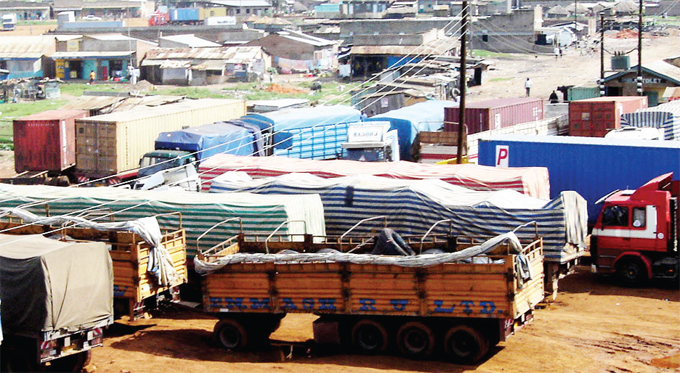 Trailers awaiting clearance at Uganda Malaba customs parking yard
Trailers awaiting clearance at Uganda Malaba customs parking yard
GDP stagnant
But according to the Civil Society Budget Advocacy Group (CSBAG), the country is still below potential when other indicators such as tax-to GDP ratio are considered, despite the increase in collections.
Officials say the country’s tax to GDP ratio has stagnated at about 11% over the last 10 years, falling behind the 16% Sub- Saharan average.
Owing to the country’s many development needs, government expenditure has over the years exceeded revenue collection, compelling the Government to resort to other sources to finance the deficit.
As a result, the country’s stock of public debt has almost tripled in the last ten years, from $2.9b in 2006 to $8.7b in 2016.
“Although this is still within manageable levels, the pace of growth, as well as ongoing infrastructure investments, call for an increase in domestic revenue mobilisation to reduce growth in public debt,” Julius Mukunda, the CSBAG executive director, says.
Mukunda explains that the biggest constraint to revenue mobilisation in Uganda is the continued dependence on international trade taxes.
This was despite noted reduction in their share of revenue collection over the years. CLICK HERE FOR MORE ON THIS STORY
Welcome to Arua, the pride of West Nile region
By Robert Ariaka
It is a big business centre and regional hub for South Sudan and most of the eastern Democratic Republic of Congo (DRC).
Arua district is the oldest and one of the nine districts that make up the West Nile region. The other districts include: Nebbi, Moyo, Adjumani, Yumbe, Koboko, Maracha, Zombo and Pachwach. Two new districts of Terego and Madi Okollo are in the offing.
History
West Nile was the second last region to be added to Uganda. Karamoja followed in 1922. Right from its inception, West Nile was a multiethnic district, consisting of four ethnic groups – Lugbara, Alur, Madi and Kakwa.
On January 1, 1914, the colonial government transferred the southern part of the former Lado enclave from the Anglo-Egyptian ruled Sudan condominium to Uganda.
The source of River Nile was one key reason the British government convinced Belgium to carve West Nile and make it part of Uganda.
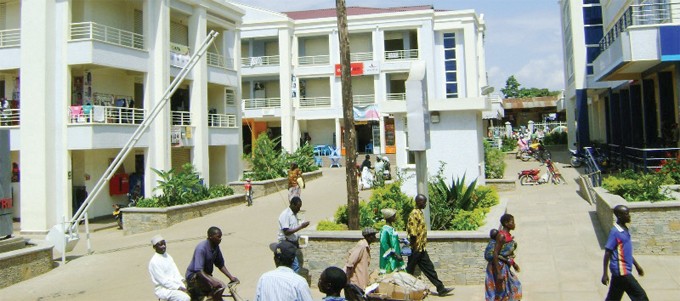 KKT Centre shopping mall in Arua town
KKT Centre shopping mall in Arua town
But the name West Nile was approved in May 1914, after the suggestion by the local officials that the new district be called Bahr-el-Gebel was turned down by the governor, according to Mark Leopold, quoting information from the Uganda National Archives in his book Inside West Nile.
In the same year, the colonial administration discussed township on the current Arua municipality and made it the centre of administration for the new district.
Arua district has a total population of 782,077 people, according to the 2014 National Population and Housing Census. More pressure has been added with the refugee population.
Old as it is, Arua municipality is steadily emerging as a premier investment destination and centre for business, education and tourism, sustained by rich cultures and conducive weather.
It is a cosmopolitan town thriving with trade due to its strategic location within the confluence of Uganda, South Sudan and eastern DRC; having dozens of high rise residential buildings, hotels and towering shopping centres.
The town has kept its traditional Lugbara cone-shaped grass-thatched houses in some villages, presenting an interesting blend of both the past and the present. CLICK HERE FOR MORE ON THIS STORY
Uganda becomes regional pacifier
Over time, especially for the past 30 years under President Yoweri Museveni’s leadership, Uganda has cut a father figure role in the stabilisation of the region under what government describes as a contribution to the wider goal of Pan-Africanism. As the NRM/A celebrates January 26, the day Museveni captured power, DAVID LUMU traces Uganda’s towering role in ensuring that the country and its neigbhours are peaceful, stable and secure
When he officially opened the annual judges conference at Speke Resort Munyonyo on Monday, President Yoweri Museveni made what has been described by pundits as a ‘pregnant’ statement.
“I urge the other units of government to borrow a leaf from the Army. We have defended the country even with very scarce resources.
We have never gone on strike to demand better pay. We die so that there is peace. And not just peace in Uganda, but regional peace,” he said.
The above statement captures the journey the country has taken ever since NRM/A captured power in 1986.
“President Museveni came to power in 1986 after decades of internal strife. Under Museveni, Uganda has experienced relative political stability, democratic progress, and economic growth. Uganda has been a reliable partner for the US in promoting stability in the Horn of Africa and East/Central Africa and combatting terror, particularly through its contribution to the African Union Mission in Somalia,” the US Department of State notes in its lengthy description of Uganda-US relations.
 UPDF soldiers in Somalia. Uganda, under AMISOM, has tirelessly worked to bring peace in Somalia
UPDF soldiers in Somalia. Uganda, under AMISOM, has tirelessly worked to bring peace in Somalia
Somalia
The most visible foreign operation by Ugandan armed forces is that of Somalia, which started in 2007, with Uganda as the only country that dared to pacify Somalia, under the African Union Mission in Somalia.
To some people, including Dr. Opiyo Oloya, the author of Black Hawks Rising: The Story of AMISOM’s Successful War Against Somalia Insurgents, 2007-2014, Uganda’s deployment of troops in Somalia was viewed as a futile exercise.
But for over a decade, Uganda’s mission in Somalia has become one of the major foreign operation successes.
Oloya argues in his book that the Somalia mission, which he viewed as dead on arrival, expanded from the Mogadishu enclave, and took on Somali al-Shabaab terrorists, in order to expand the Somalia government territory.
For the first time, Oloya argues that Ugandan troops in conjunction with their Kenyan and Burundi counterparts had clinically executed what the US had failed to do during its Somalia mission before the regional African troops were deployed in Somalia. CLICK HERE FOR MORE ON THIS STORY
Sports can turn Uganda into middle-income country
By James Bakama
Uganda, like most developing countries, does not take sports seriously.
There is a casual approach to the sector, which the Government says will be more seriously addressed when more pressing issues such as infrastructure, health and education have been fully attended to.
Sport is, as a result, perceived more as just play. This attitude has over the past 32 years of this Government’s reign been reflected in the minimal budgets annually allocated to the sector. Sports facilities around the country also continue to be snapped up for other nonsector- related ventures
Low budget
Unknown to authorities is the fact that this is a sector that could turn around Uganda’s fortunes. Sports could in fact serve as the magic wand because of its multiple benefits that ultimately result in development.
The sector that has 54 disciplines registered with the National Council of Sports in recent years has been averaging sh11b in budgetary allocations. The industry was recently boosted with a sh15b supplementary budget.
But even this, experts in the sector say, is inadequate. Sports commissioner Omara Apita is one of those who have continually made a case for increased attention for the sector. “We could comfortably operate with at least sh50b budget,” Apita stated in a 2013 interview.
 Kiprotich’s London 2012 Olympics victory was seen by at least three billion people
Kiprotich’s London 2012 Olympics victory was seen by at least three billion people
Promoting health
According to Apita, there are numerous benefits that can accrue from this sector to improve the lives of Ugandans.
Active participation in sports improves community health and productivity and reduces medical expenses.
Scientific studies have proved that physical activity, including sports, reduce the risk of over 20 illnesses, including cardiovascular disease and some cancers.
Consider the impact on a country’s health budget of a nation whose citizens are seriously involved in sport.
A country like Japan, which has deliberate mass sport national policy, has a life expectancy of 85 years. Compare that to Uganda, whose expectancy is 59. CLICK HERE FOR MORE ON THIS STORY
Govt moves to strengthen land rights for women and children
By Pascal Kwesiga
Carolyn Businge, a resident of Nsonga village, Buhuka parish in Hoima district, has lived on communal land with several other families almost all her life.
But Businge, the mother of three, and other families had, until recently lost their rights over communal land in the parish, where the Kingfisher oil discovery area is located.
Between 2006 and 2010, individuals acquired land titles for the communal land covering over five villages in Kyangwali sub-county. The lands ministry, which issued the 14 titles, with each covering between 150 and 170 hectares, says they were created for the individuals fraudulently, in connivance with the area land committee and the district land board.
But the land registry in 2016 cancelled the titles on the orders of lands minister Betty Amongi.
The ministry mobilised the families in the affected villages – Nsonga, Ikamiro, Nsunzu, Kyabasambu, Kyakapere, Kiina, Ngurwe and Buhuka – to form a communal land association (CLA) so they could have their land registered and a title created.
“We are waiting for the title from the ministry eagerly because that will confirm that, for the first time, we have a legal document showing we own the land,” Businge says, “The title has all our names, including those of our husbands. That means men and women have equal rights on this land.”
 Amongi (left) with officials from the Office of the Prime Minister taking a close look at a map of Kyaka 1 settlement land in Kyegegwa. The minister was in the area to solve a land dispute. Photos by Rogers Sunday
Amongi (left) with officials from the Office of the Prime Minister taking a close look at a map of Kyaka 1 settlement land in Kyegegwa. The minister was in the area to solve a land dispute. Photos by Rogers Sunday
Land owned only by men?
In many communities in Uganda, especially where customary tenure is the only form of ownership, land is owned by men, but women only have access and user rights.
Yet it is mainly women who cultivate the land to feed families on (land) owned by their spouses. Some men still dispose of what should be family land without the consent of the wives, although the Land Act 1998 outlaws the practice.
But the formation of CLAs, which strengthens and enables all members to acquire registrable interests, is one way the Government is strengthening security over land for women. “Under the CLA arrangement, every member has equal stake on land and it cannot be disposed of without the consent of everyone, including women.
When the compensation for part of our land, which is being used by the oil company comes, we shall share it equally,” Steven Rwamukaaga, the LCI chairperson at Nsonga village, says. CLICK HERE FOR MORE ON THIS STORY
Kenya overtakes South Sudan as Uganda’s top export destination
By Jackie Achan
In 1986, the total output of the Ugandan economy stood at $5.2b. However, as of the endof last year, the total output of the economy was $27.2b.
Revenue collection on the other hand was less than sh5b in 1986, but as of the end of the 2016/2017 financial year, it stood at sh12.7 trillion.
By 1994 , Uganda was exporting to the tune of $461m. However, currently the country’s export stands at $3.16b, which is a great improvement and growth.
Leading export products
Dr Elly Twineyo, the executive director of Uganda Export Promotion Board (UEPB), says as of 1986, Uganda was exporting only 12 products.
These included coffee, tea, cotton and tobacco, which were called the traditional exports. Currently, Uganda exports in excess of 40 products.
“Coffee is still a leading export commodity for Uganda. It brought in over $400m in the 2016/2017 financial year,” Twineyo says.
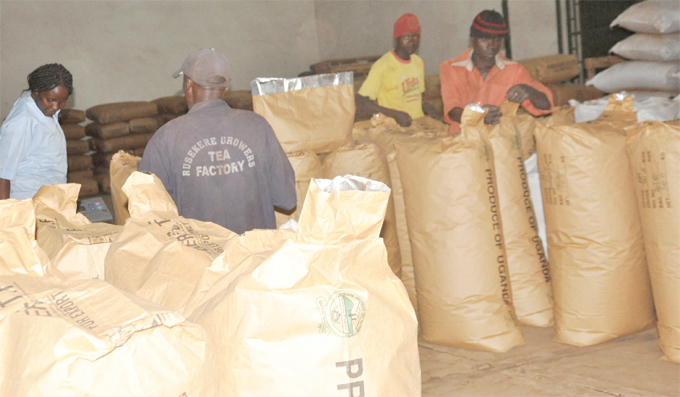 Packed tea leaves ready for export. Uganda’s export products have increased over the years
Packed tea leaves ready for export. Uganda’s export products have increased over the years
Coffee is followed by gold that brought in over $339m, then industrial products bringing in $339m, followed by fish with $131m, thanks to the Uganda People’s Defence Force (UPDF) intervention on Lake Victoria that has curbed illegal fishing.
Twineyo says other than the major export products, many other smaller ones are bringing in $70 to $80m in export earnings for the country. Maize is particularly outstanding from both its informal and formal exports.
A recent report by United States Agency for International Development (USAID) and Food And Agricultural Organisation (FAO) found Uganda is exporting a lot of informal foods, more so maize which composed 70% of all informal exports.
The Central Bank statistics also indicate that informal exports brought in $45.5m in the 2016/217 financial year. With the formal exports standing at over $72m and informal exports at $45m, the total figure stands at an over $117m. CLICK HERE FOR MORE ON THIS STORY
Aviation industry set for boom
Every year, on January 26 the country commemorates Liberation Day when the NRM came to power. Vianney M. Luggya the manager public affairs at Civil Aviation Authority in an interview with Jacky Achan takes stock of what the aviation industry has achieved over the last 32 years.
Q: Entebbe is the only international airport in Uganda. Would you say that there is enough aviation business in Uganda?
A: More than 90% of air traffic for any country is determined by the size of the economy (measured by Gross Domestic Product) for that country. As Uganda’s economy continues to grow, the country’s air traffic grows and more air operators are subsequently attracted to benefit from the passenger and cargo traffic. The International Monetary Fund (IMF) has projected Uganda’s GDP to grow by 5.2% and 7.3% in 2018 and 2022, respectively. It is anticipated that the country’s air traffic will follow the same positive trend. There is also a lot of potential in the horticultural industry. Most of Uganda’s exports to Europe and other foreign markets comprise of fresh produce, including flowers, fish and the like.
We have heard reports that some carriers have abandoned Entebbe. How do you plan on changing such a trend?
At the time of CAA’s establishment in 1991, there were 118,000 international passengers through Entebbe compared to over 1.5 million in 2016.
Three new airlines have joined the Ugandan airspace in the last three years and discussions are on-going with the Lufthansa Group and Saudia Cargo, among others, to commence operations in and out of Uganda in the near future.
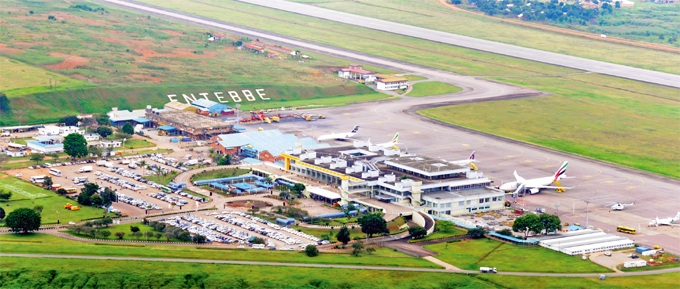 An aero photo of Entebbe International Airport. Business at the airport is becoming more vibrant with three new airlines said to be joining the Ugandan air space
An aero photo of Entebbe International Airport. Business at the airport is becoming more vibrant with three new airlines said to be joining the Ugandan air space
Uganda recently concluded new bi-lateral air service agreements with Saudi Arabia, Israel, Switzerland and Canada. Some of Canada’s airlines are already having code-share agreements with international operators to Uganda.
In addition, a number of existing air operators, such as Emirates, Qatar and Rwanda Air, among others have recently changed aircrafts to Entebbe from smaller to bigger ones. Emirates changed from using an Airbus 330, which had a load capacity of 220 passengers to a Boeing 777 aircraft with a load capacity of 360 passengers.
Similarly, Qatar Airways upgraded from using an Airbus 320 that carried 144 passengers to an Airbus 330- 200 with a load capacity of up to 260 passengers. While British Airways suspended operations in 2015, several other international airlines have since expanded their operations in Uganda.
For instance, Ethiopian Airlines increased flights between Entebbe and Addis Ababa from two flights a day to three flights per day and added another route to Juba, to make a total of 28 frequencies per week.
Brussels Airlines recently increased its flights from five to seven flights per week, effective 1 December, 2017. In the same year, Kenya Airways started operating six frequencies a day on Monday, Tuesday, Thursday, Friday and Saturday of every week while maintaining five frequencies per day on Wednesdays and Sundays, making a total of 40 frequencies per week.
Similarly, Turkish Airlines has on top of their current daily passenger flights added a second cargo flight per week. Another international air operator is considering doubling their daily flights in and out of Entebbe.
All these developments, including increase in frequencies by air operators and change of aircraft from smaller to bigger types, show that Uganda’s air transport industry is growing steadily and so is the competition. Passenger traffic in and out of Entebbe International Airport has greatly increased. CLICK HERE FOR MORE ON THIS STORY
Govt making headway in combating corruption
By John Masaba
Hardly a day goes by without a corruption incident making headlines in the media in Uganda.
From issues of individuals acquiring land titles on gazetted public resources such as lakes and wetlands to public officials siphoning hapless elderly civil servants of their pension. It is hard to believe there is any humanity left in the hearts of public officials.
This begs the question: Does that indicate the country is rotten to the core and government is now at the mercy of self-seeking public officials?
That is a question whose answer calls for debate. However, an analysis of what the Government has done in the fight against corruption indicates that there is a lot being done that should bring hope for a corruption-free Uganda
 Businessman Apolo Senkeeto chatting with his lawyer Peter Mulira after appearing at the Anti Corruption Court in Kampala in the case of causing sh24b financial loss to the Government in the botched Mukono-Katosi road project last year
Businessman Apolo Senkeeto chatting with his lawyer Peter Mulira after appearing at the Anti Corruption Court in Kampala in the case of causing sh24b financial loss to the Government in the botched Mukono-Katosi road project last year
Anti-corruption agencies
To demonstrate its commitment to the fight, the Government established an ethics and integrity ministry to co-ordinate the anticorruption crusade and appointed a minister to be the political head of this ministry.
Through the police, the Government created an anti-corruption unit under its criminal investigation department to be able to hunt down those who are stealing public funds with the swiftness required to arrest them.
The same has been the case with the Judiciary, which has an anti-corruption division at the High Court level to be able to expeditiously handle corruption cases and eliminate backlog.
According to Richard Ssewakiryanga, the executive director of National Non- Governmental Organisation (NGO) Forum, a platform of over 630 NGOs working in Uganda, this shows that Uganda is doing well in establishing the legal framework.
While setting the scene for the symposium, Ssewakiryanga highlighted the different legal framework available to fight corruption, such as the Constitution, Leadership Code Act, Whistle Blowers Act, the Inspectorate of Government (IGG) Act, Anti-Corruption Act; Access to Information Act and the Anti- Pornography Act. CLICK HERE FOR MORE ON THIS STORY
ADVERTS
SBI INTERNATIONAL HOLDINGS AG (UGANDA)
ARUA DISTRICT LOCAL GOVERNMENT
MINISTRY OF WORKS AND TRANSPORT
UGANDA NATIONAL OIL COMPANY LIMITED
COTTON DEVELOPMENT ORGANISATION
UGANDA REGISTRATION SERVICE BUREAU
MINISTRY OF AGRICULTURE ANIMAL INDUSTRY & FISHERIES
UGANDA ALLIED HEALTH EXAMINATIONS BOARD
UGANDA BUSINESS AND TECHNICAL EXAMINATIONS BOARD (UBTEB)
MINistry OF AGRICULTURE, ANIMAL INDUSTRY AND FISHERIES (MAAIF)
ARUA TECHNICAL INSTITUTE - RAGEM
MINISTRY OF INFORMATION, COMMUNICATIONS TECHNOLOGY AND NATIONAL GUIDANCE
[asset_library_tag 573c98b3-4b41-4afe-b6c7-608e31386d22,MINISTRY OF HEALTH]
Ugandans can now live fifteen years longer
By Cecilia Okoth
Ugandans on average now live 15 years longer today than when the National Resistance Movement (NRM) government first came to power in 1986.
According to the health status and associated factors thematic series based on the 2014 National Population and Housing Census (NPHC) and published by the Uganda Bureau of Statistics (UBOS) in November last year, the life expectancy for Uganda at birth, as of 2014, was 63.7 years.
If born today, men can live up to 62.8 years and women up to 64.5 years. However in 1986, life expectancy was 48.7 years. Then women were living up to 50.5 years whereas men were living upto 45.7 years.
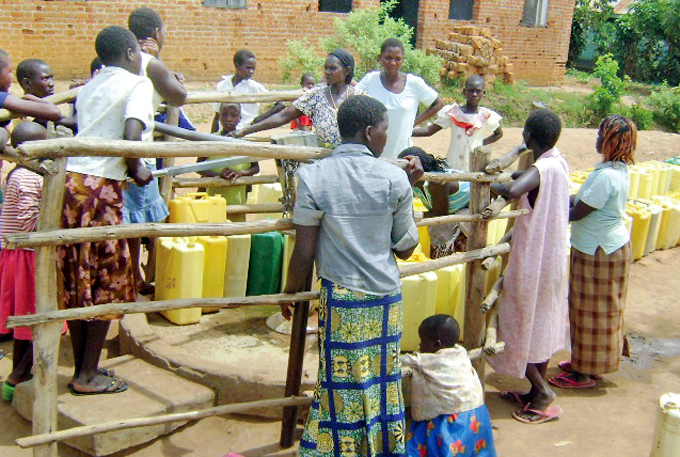 Increase in life expectancy in Uganda has been attributed to improved sanitation and access to clean water among other services
Increase in life expectancy in Uganda has been attributed to improved sanitation and access to clean water among other services
Females live longer
Females were and still are known to live longer than males for both biological and behavioural reasons. In terms of biological reasons, women possess genes that expose them to longer life than men.
In terms of behaviour, women pay more attention to their health and seek care when they are sick more frequently than their male counterparts.
They are also less prone to risky behaviour, such as smoking, as well as alcohol and drug consumption. Women are also less likely to suffer from risk of injuries and violent death from traffic accidents and exposure to occupational risks.
Life expectancy, as defined by UBOS, is a measure that is often used to gauge the overall health of a community. The indicator is measured as “Life Expectancy at birth”, which is an estimate of the average number of years that a newborn is expected to live, subject to the population’s mortality risks at the time of birth.
It also gives a summary measure of the mortality experience of the population at all ages, an important indicator of the health and socio-economic status of the population that is being monitored in the National Development Plan (NDP) and is a key element of the long and healthy dimension of Human Development Index (HDI). CLICK HERE FOR MORE ON THIS STORY
Uganda makes strides in family planning
By Jacquiline Emodek
When the National Resistance Movement took over power in 1986, the country was still recovering from a period of civil and military unrest, with resultant destruction of social infrastructure.
Consequently, the Government introduced and implemented a recovery programme aimed at steadily moving the country towards economic prosperity; some of the social economic indicators of the programme were women of child bearing age, population growth rate and the ratio of hospital beds to the population. Uganda, therefore, needed baseline information for planning and implementing national and regional programmes.
This led to the country’s first demographic health survey (DHS) 1988-89, which covered a sample of 4,730 women and excluded nine northern districts due to insecurity.
The survey provided information on fertility, family planning and child health. The first DHS data indicated that fertility in Uganda was high with women having an average of seven births, something which had been consistent over the past 15 years.
Fertility was linked to a woman’s level of education and child bearing age, which stood at 20 years (60%) and less than 3% having their first birth at the age of 25 or older.
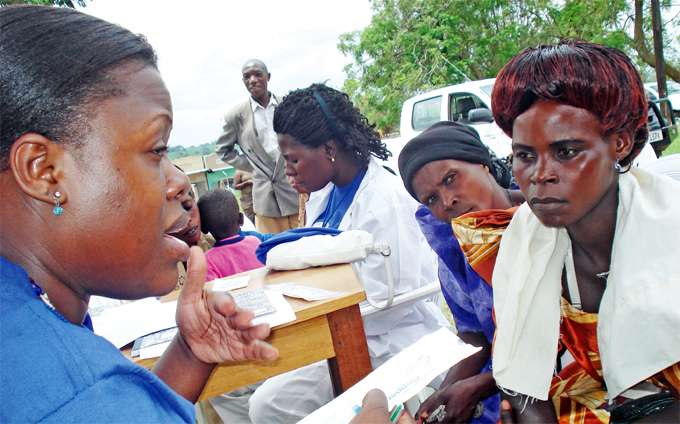 Health workers from PACE sensitising women about family planning in Masaka
Health workers from PACE sensitising women about family planning in Masaka
Contraceptive use
The report further cited the low level of contraceptive use in the country as one of the leading factors contributing to high fertility.
Notably, family planning activities in Uganda started in 1957 with the establishment of the Family Planning Association of Uganda (FPAU) an affiliation of the International Planned Parenthood Federation.
When the previous government introduced its primary healthcare strategy, it integrated family planning into overall maternal and child health programme as a means of reducing maternal morbidity and mortality in Uganda.
The family planning services offered were oral contraceptives, female sterilisation, injectables, condoms, with few couples using IUDs and a natural family planning programme organised by the Uganda Catholic Medical Secretariat.
However, most of the services were largely limited to urban centres despite the fact that over 80% of the population resided in rural areas.
“Although 84% of currently married Ugandan women know at least one contraceptive method and 77% know a source for a contraceptive method, only 22% have ever used a method and only 5% are currently using a method,” the report adds. CLICK HERE FOR MORE ON THIS STORY
Transformation of vocational education since 1986
By Ritah Mukasa
Vocational education has come a long way from 1986 to date, changing face from being an option for students who have failed to attain the required grades. Currently, it is an alternative to quick employment and job creation.
Michael Okumu, the deputy director at the directorate of industrial training, under the education ministry, notes that from the 1980s to the early 1990s, vocational education was perceived negatively by the masses — both parents and students.
“They branded it a thing for those who have failed to raise the required grades to proceed to the next secondary school level or those who cannot raise school fees,” he explains.
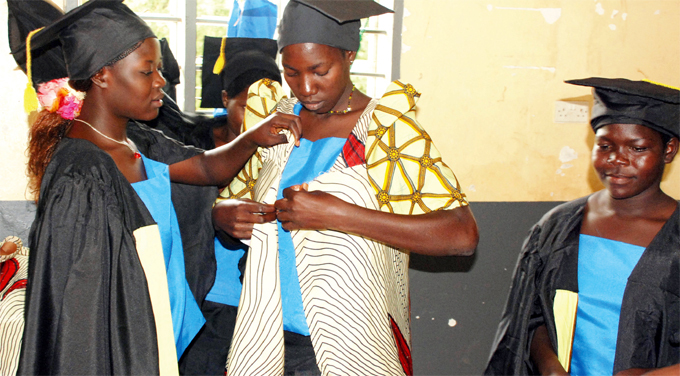 Graduands from Bbira Vocational Traininig School showing off their products. Vocational training is the key to Uganda’s unemployment problem
Graduands from Bbira Vocational Traininig School showing off their products. Vocational training is the key to Uganda’s unemployment problem
Elsewhere, parents in extended families would branch dependents to vocational schools for financial relief as their own continued to secondary and universities. Additionally, unruly children, who parents did not want to drop out of school, were dumped in vocational schools as a punishment to tame them. However, Okumu appreciates the great milestones that have been achieved after the government and other stakeholders came out to popularise vocational education, more so, skills training as a way to curb unemployment.
He recalls that back in the day, Uganda had very few vocational and technical schools, both governmentowned like Kyambogo and private (Church-founded) like Kisubi technical institute. Okumu adds that apart from the limited structures, these schools also had inexperienced artisans and few students.
Even at the education ministry, for sometime, the technical education department had only three workers. However, as time went by, the government realised the need to popularise skills development, hence growing the department to a more vibrant and broader section today. CLICK HERE FOR MORE ON THIS STORY
